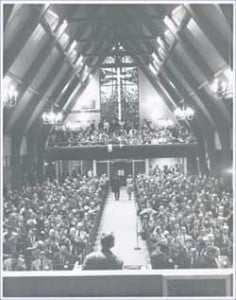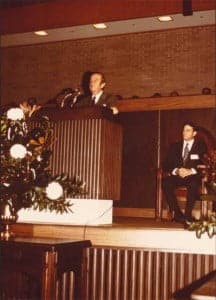This year marks the 40th anniversary of the organization of the Presbyterian Church in America. The denomination’s First General Assembly met December 4-7, 1973. Policy wonks can view the Minutes of that First General Assembly, here.
They Had No Manual, but a New Presbyterian Church was Born
 Gathering in Briarwood Presbyterian Church in Birmingham, Alabama, were teaching and ruling elders ready to begin a new Presbyterian denomination. Their date of gathering, or organization, was December 4, 1973, as date consciously chosen with an eye to the past. They began this new Reformed church on the same day and month as the organization date for the mother church that they were leaving, the Presbyterian Church, U.S., commonly known in those years as the Southern Presbyterian Church. That denomination had begun on December 4, 1861 as the Presbyterian Church of the Confederate States of America. Later, that name was changed to the Presbyterian Church in the United States, after the War between the States.
Gathering in Briarwood Presbyterian Church in Birmingham, Alabama, were teaching and ruling elders ready to begin a new Presbyterian denomination. Their date of gathering, or organization, was December 4, 1973, as date consciously chosen with an eye to the past. They began this new Reformed church on the same day and month as the organization date for the mother church that they were leaving, the Presbyterian Church, U.S., commonly known in those years as the Southern Presbyterian Church. That denomination had begun on December 4, 1861 as the Presbyterian Church of the Confederate States of America. Later, that name was changed to the Presbyterian Church in the United States, after the War between the States.
In choosing to organize the new denomination on that anniversary date, the new denomination was making a statement, laying claim as the faithful continuing church, the remnant leaving behind the unfaithful or disobedient. In fact, the Continuing Presbyterian Church was the name that they first gathered under in the years and months leading up to their official organization. That they did not desire to continue as yet another regional church was evidenced by the name they chose for the new denomination, the National Presbyterian Church (though a year later, that name was changed to the Presbyterian Church in America).
 Reformed men were obviously interested in reforming the church. And so ever since it was clearly discovered that the Presbyterian Church in the United States had apostatized with no hope to bring it back to its historic roots, men and women had been praying and working, and working and praying, for this historic occasion. Ruling Elder W. Jack Williamson was chosen as the first moderator, with Dr. Morton Smith elected as Stated Clerk. Ministries then in planning and those already exercised in action, came together in rapid fashion: Mission to the World, Mission to the United States, Christian Education and Publications were organized by the delegates. With godly and wise coordinators to lead them, the work began to raise up a church faithful to the Scriptures, true to the Reformed Faith, and obedient to the Great Commission of Jesus Christ.
Reformed men were obviously interested in reforming the church. And so ever since it was clearly discovered that the Presbyterian Church in the United States had apostatized with no hope to bring it back to its historic roots, men and women had been praying and working, and working and praying, for this historic occasion. Ruling Elder W. Jack Williamson was chosen as the first moderator, with Dr. Morton Smith elected as Stated Clerk. Ministries then in planning and those already exercised in action, came together in rapid fashion: Mission to the World, Mission to the United States, Christian Education and Publications were organized by the delegates. With godly and wise coordinators to lead them, the work began to raise up a church faithful to the Scriptures, true to the Reformed Faith, and obedient to the Great Commission of Jesus Christ.
› Photo from the First General Assembly in 1973, with W. Jack Williamson at the podium, and Rev. Frank Barker seated, at the right.
Words to live by: There is usually great excitement over a new birth in a family. And so there was great excitement over the birth of a new denomination. Southern conservative Presbyterians had gone through many of the same struggles that Northern conservative Presbyterians endured just a few decades earlier. In both cases, the Church had been hijacked by the liberals. But godly men and women stood for the faith once delivered unto the saints, and wouldn’t let historical attachments hold them captive to a decaying visible church. They voted with their feet and came out and were now separate. Praise God for their obedience to the Word of God and the testimony of Jesus Christ.
Tags: First General Assembly, General Assembly, Jack Williamson, Jesus Christ, PCA, Presbyterian Church, United States
-
These quotes are from the above statement: “In choosing to organize the new denomination on that anniversary date, the new denomination was making a statement, laying claim as the faithful continuing church, the remnant leaving behind the unfaithful or disobedient… Reformed men were obviously interested in reforming the church. And so ever since it was clearly discovered that the Presbyterian Church in the United States had apostatized with no hope to bring it back to its historic roots, men and women had been praying and working, and working and praying, for this historic occasion.” I wonder how these strong words can be reconciled with this statement of the new PCA Assembly on December 7th 1973: “Some of our brethren have felt that the present circumstances do not yet call for such a remedy. They remain in the Presbyterian Church in the United States. We trust they will continue to contend for the faith, though our departure makes their position more difficult. We express to them our hope that God will bless their efforts, and that there may come a genuine spiritual awakening in the Presbyterian Church in the United States.
We trust that our departure may cause those who control and direct the programs and policies of the Presbyterian Church in the United States to reexamine their own position in the light of the Word. Our prayer is that God may use this movement to promote spiritual awakening, not only in the new Church, but also in that from which we have separated. If in the providence of God, such were to occur, we would gladly acknowledge that the grounds for separation and division would have to be reassessed.” How could that hope be expressed “that God will bless their efforts” and that “there may come a genuine spiritual awakening in the Presbyterian Church in the United States” in light of those former words? If the said Presbyterian Church had “apostatized with no hope to bring it back to its historic roots” (the exact words of the PCA in the article above) how could prayer be urged for its revival and renewal? This is the kind of double-speak that has marked the PCA from the outset. That spirit of compromise was endemic to the PCA from its foundation and it continues to this day i.e. churches and ministers who believe in literal 6-day creation, for example, and others who do not. A mixed bag it still is, and more so since 1973.

2 comments
Comments feed for this article